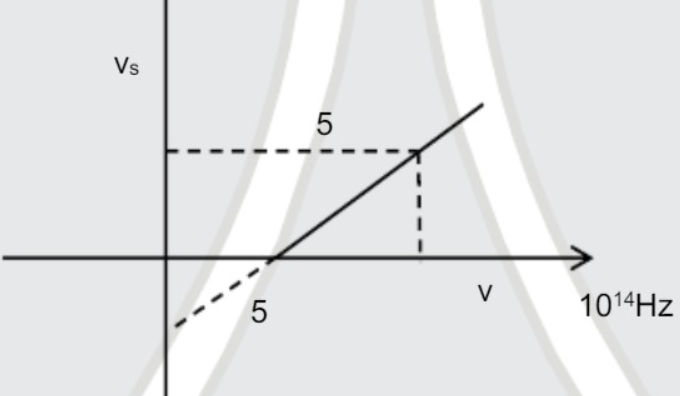Assertion : The stopping potential depends on the frequency of incident light.
Reason : The stopping potential is related to maximum kinetic energy by .
If both assertion and reason are true and reason is the correct explanation of assertion.
If both assertion and reason are true but reason is not the correct explanation of assertion.
If assertion is true but reason is false.
If both assertion and reason are false.
The correct Answer is:A
To solve the question, we need to analyze both the assertion and the reason provided.
Step 1: Understand the Assertion
The assertion states that "The stopping potential depends on the frequency of incident light."
Explanation: The stopping potential (V₀) is the potential needed to stop the most energetic photoelectrons emitted from a material when light shines on it. According to the photoelectric effect, the energy of the incident light is given by E = hν, where h is Planck's constant and ν is the frequency of the light. Therefore, the stopping potential is indeed related to the frequency of the incident light.
Step 2: Understand the Reason
The reason states that "The stopping potential is related to maximum kinetic energy by eV₀ = Kₘₐₓ."
Explanation: This is a fundamental relation from the photoelectric effect. The maximum kinetic energy (Kₘₐₓ) of the emitted electrons can be expressed as Kₘₐₓ = eV₀, where e is the charge of the electron. This means that the stopping potential is directly related to the maximum kinetic energy of the emitted electrons.
Step 3: Relate the Assertion and Reason
Now, we can relate both the assertion and the reason.
From Einstein's photoelectric equation:
Kmax=hν−φ
where φ is the work function of the material.
Substituting Kₘₐₓ with eV₀, we get:
eV₀=hν−φ
From this equation, we can see that the stopping potential (V₀) is directly influenced by the frequency (ν) of the incident light. Thus, as the frequency of the incident light changes, the stopping potential also changes.
Conclusion
Both the assertion and the reason are true, and the reason correctly explains the assertion.
Final Answer
Both the assertion and the reason are true, and the reason is the correct explanation of the assertion.
The assertion states that "The stopping potential depends on the frequency of incident light."
The reason states that "The stopping potential is related to maximum kinetic energy by eV₀ = Kₘₐₓ."
Now, we can relate both the assertion and the reason.
Kmax=hν−φ
where φ is the work function of the material.
eV₀=hν−φ
Both the assertion and the reason are true, and the reason correctly explains the assertion.
Both the assertion and the reason are true, and the reason is the correct explanation of the assertion.
Topper's Solved these Questions
- BOOK - NCERT FINGERTPS ENGLISHCHAPTER - DUAL NATURE OF RADIATION AND MATTER EXERCISE - Einstein'S Photoelectric Equation : Energy Quantum Of Radiation23videos
DUAL NATURE OF RADIATION AND MATTER
- BOOK - NCERT FINGERTPS ENGLISHCHAPTER - DUAL NATURE OF RADIATION AND MATTER EXERCISE - NCERT Exemplar8videos
DUAL NATURE OF RADIATION AND MATTER
- BOOK - NCERT FINGERTPS ENGLISHCHAPTER - DUAL NATURE OF RADIATION AND MATTER EXERCISE - EXEMPLAR PROBLEMS8videos
DUAL NATURE OF RADIATION AND MATTER
- BOOK - NCERT FINGERTPS ENGLISHCHAPTER - CURRENT ELECTRICITYEXERCISE - Assertion And Reason15videos
CURRENT ELECTRICITY
- BOOK - NCERT FINGERTPS ENGLISHCHAPTER - ELECTRIC CHARGES AND FIELDSEXERCISE - Assertion And Reason15videos
ELECTRIC CHARGES AND FIELDS
Similar Questions
If the frequency of incident light is tripled, the stopping potential will
View SolutionAssertion: Stopping potential depends upon the frequency of incident light but is independent of the intensity of the light.
Reason :The maximum kinetic energy of the photoclectrons is proportional to stopping potentialView Solution
Knowledge Check
- Question 1 - Select One
In photoelectric effect, stopping potential depends on
Afrequency of incident lightBnature of the emitter materialCintensity of incident lightDboth (a) and (b) - Question 2 - Select One
The work function of Cs is 2.14 ev find the wavelength of the incident light if the stopping potential is 0.6 V.
A326 nmB454 nmC524 nmD232 nm
The slope of frequency of incident light and stopping potential for a given surface will be
View SolutionGraph between stopping potential and frequency of light as shown find the work function
 View Solution
View SolutionAssertion: If frequency of incident light is doubled, the stopping potential will also become two times
Reason: Stopping potential is given by V0=he(v−v0)View SolutionDefine the term 'stopping potential' in relation to photoelectric effect.
View SolutionLight of energy 2.0 eV falls on a metal of work function 1.4 eV . The stopping potential is
View SolutionIf the frequency of light in a photoelectric experiment is doubled the stopping potential will
View Solution

